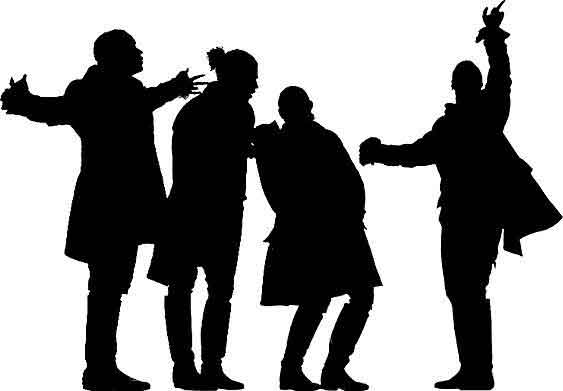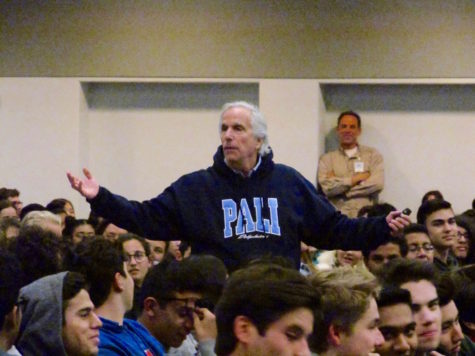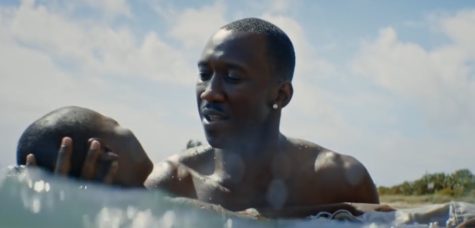Some “Serious Criticism”
Lin-Manuel Miranda “passionately smashes every expectation,” yet Hamilton falls short of being truly revolutionary.

Courtesy of Creative Commons
Around the two-minute mark of the song “What’d I Miss” from Hamilton, the hit musical set during and after the Revolutionary War, Thomas Jefferson sings the chilling line “Sally be a lamb darling won’t you open it?” The line is one of the few references to the period’s institution of slavery; Sally is Sally Hemings, a slave who Jefferson owned and raped for years, starting when she was a teenager, who he impregnated six times.
She is also the only historically black character to appear in the production.
It’s an easy detail to miss. The Pulitzer Prize-winning musical has been lauded for its innovative multiethnic casting of a historically white group of men. It’s a decision that has resonated with audiences during the year of #OscarsSoWhite, a hashtag that lambasted the entertainment industry for its lack of diversity.
Hamilton-hype extends far beyond the casting; nearly every aspect of the show has been idolized. Hamilton has recently been nominated for a record 16 Tony Awards. Its creator, Lin-Manuel Miranda, is the recipient of a MacArthur “Genius” Grant, and may very well become the first person to PEGOT (win a Pulitzer, Emmy, Grammy, Oscar and Tony). The musical almost singlehandedly kept the first Secretary of the Treasury, Alexander Hamilton, on the $10 bill and has been praised with reinvigorating interest in U.S. history. It also may be the only common ground between Democrats and Republicans, with President Barack Obama commenting that Hamilton’s “the only thing Dick Cheney and I agree on.” At a time when faith in the American political system is at a low, Hamilton presents an optimistic view of the Founders and their intentions.
Near-universal praise has insulated Hamilton from criticism. Harvard professor Annette Gordon-Reed, who brought the nature of Jefferson’s relationship with Hemings to light with her book The Hemingses of Monticello, wrote: “One of the most interesting things about the Hamilton phenomenon is just how little serious criticism the play has received.”
However, while the musical highlights the story of an under-sung Founding Father and fleshes out the convoluted politics of the time, it excludes the experiences of African-American historical figures and brushes over slavery in a bizarre whitewashing of history.
It’s a fallacy to believe that African-Americans were not actively involved in the American Revolution. Freedmen and slaves played important roles on both sides. Despite this, Hemings is the only black character in the play, and hers is only a walk-on part at that. Key figures who could have easily been included are left out for no apparent reason. Crispus Attucks, the half-Native American, half-African man who died in the Boston Massacre and is considered the first casualty of the Revolutionary War, is not mentioned. Neither is James Armistead, a black slave who joined the American side as a spy, providing intel that was vital to the decisive victory at Yorktown. Armistead’s exclusion is especially strange, as he worked closely with the Marquis de Lafayette, eventually adopting his name. Given the amount of stage time the Marquis receives, it’s bizarre that Armistead doesn’t even come up in conversation.
The strangest exclusion, however, is that of Cato, a slave owned by American spy Hercules Mulligan. Cato aided Mulligan with “taking the measurements, the information and then smuggling it,” serving an important role in the Revolution. Mulligan isn’t exactly a name brand character of the time; it’s doubtful that many Hamilton fans would have known of him before the musical. However, he receives a sizable amount of stage time while Cato goes unseen and unmentioned.
These exclusions could be dismissed as the necessary cuts that need to be made in a musical adaptation. Musicals, adaptations in particular, are much better at capturing the feeling of an era or work rather than the details. Characters need to be cut, time stretched or condensed, moments picked for emotional effect and choreography. Compared to others, Hamilton does a better job than most of capturing the politics and history of the period. However, the show cannot be excused for leaving out such an important feature of the time.
The Revolution and the founding of the United States was a time of strange contradictions when a significant portion of liberal, forward-thinking men owned slaves and had no qualms about denying them liberty. Hamilton brushes over this throughout the show, never going into detail about the fact that these people, for all their foresight, were deeply flawed at their roots.
Throughout the show, the few references to slavery made are mainly used as a means of differentiating “bad” characters from “good” characters. This is best seen with Hamilton stinging Jefferson with the lines: “A civics lesson from a slaver. Hey neighbor / Your debts are paid ’cause you don’t pay for labor.” Meanwhile, Hamilton is painted as the good guy through a few references to his abolitionism.
It’s an important fact that Jefferson was a slaver, but the show’s treatment of slave owners is inconsistent throughout. Washington, who plays a warm, paternal role to the young Hamilton, also owned slaves and ran a large plantation at Mount Vernon, Virginia.
In fact, Hamilton himself married into the Schuyler family, for whom he bought and sold slaves. His grandson, Allan McLane Hamilton, wrote in his biography of the man: “It has been stated that Hamilton never owned a negro slave, but this is untrue. We find that in his books that he purchased them for himself and others.” A letter from Hamilton actually records his efforts to recover a slave belonging to his sister-in-law, Angelica Church (née Schuyler).
It is true that Hamilton opposed slavery — he was one of the founding members of the New York Manumission Society, an organization aimed at ending the slave trade and the voluntary freeing of slaves — but when his goals of social advancement conflicted with his abolitionism, the former beat out the latter.
In addition, Miranda and Hamilton engage in what’s known as “Founders’ Chic.” A term minted in the early 2000s after the popular success of the biographies of several revolutionaries, Founders’ Chic refers to the perception of the Founding Fathers as more liberal and “hip” than they actually were. Miranda’s music and lyrics give the Founders edge and coolness, while the glossing-over of their uglier politics gives them liberal personas that modern viewers can relate to but that split with historical reality.
Hamilton is the most innocuous offender in a tradition of erasing slavery and its effects from American history. Almost immediately after the Civil War, revisionist history began shifting importance away from slavery as a cause of the war. Birth of a Nation, the notorious KKK-produced movie glorified the position of the South and the Klan; Gone With the Wind turns slavery into a non-issue and describes slaves as happy about being enslaved; and most recently, author Stephen O’Connor has written a novel titled Thomas Jefferson Dreams of Sally Hemings, which distorts the former’s abuse of the latter into some kind of romance.
It is vital that American art, and art about the Founding Fathers, reflects the realities of history. Many of the problems facing the country today stem from the fact that slavery was legal for centuries. Currently, there is a push in Texas to amend history textbooks so that slavery takes a backseat as the cause of the Civil War. Time reported that 20 percent of Donald Trump supporters think that ending slavery was a mistake. It’s unacceptable for such a popular, visible show to ignore this reality.
Hamilton’s good. But it could be better.



